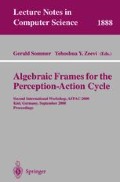Abstract
Linear statistical models of shape variability of identifiable point sets have previously been described and applied successfully to the empirical modeling of appearance variability in natural images. One of the limitations of these linear models has been demonstrated in the nonlinear “bending” shape variability of point sets where a length ratio is constant.
We point out that modeling point set variability with groups of transformations generated by linear vector fields constitute an algebraic frame for modeling simple nonlinear point set variability suitable for the modeling of shape variability. As an example, the very simple “bending” shape variability of three points in the complex plane is in this way generated by a linear vector field described by a complex 3 × 3 matrix.
Access this chapter
Tax calculation will be finalised at checkout
Purchases are for personal use only
Preview
Unable to display preview. Download preview PDF.
References
Bookstein, F.L.: Shape and the information in medical images: A decade of the morphometric synthesis. Computer Vision and Image Understanding 66(2), 97–118 (1997)
Kendall, D.G.: A survey of the statistical theory of shape. Statistical Science 4(2), 87–120 (1989)
Small, C.G.: The Statistical Theory of Shape. Springer Series in Statistics. Springer, Heidelberg (1996)
Dryden, I.L., Mardia, K.V.: Statistical Shape Analysis. Wiley Series in Probability and Statistics. Wiley, Chichester (1998)
Cootes, T.F., Taylor, C.J., Cooper, D.H., Graham, J.: Active shape models their training and application. Computer Vision and Image Understanding 61(1), 38–59 (1995)
Kent, J.T.: Concluding address. In: Mardia, K.V., Gill, C.A. (eds.) Current Issues for Statistical Inference in Shape Analysis, Department of Statistics, University of Leeds, pp. 167–175. Leeds University Press (April 1995)
Olsen, N.H.: Statistisk formbeskrivelse vha. differentialgeometrisk modellering. Master’s thesis, Department of Computer Science, University of Copenhagen, Datalogisk Institut, Universitetsparken 1, DK-2100 Copenhagen Ø, Denmark (November 1999) (in Danish)
Warner, F.W.: Foundations of Differentiable Manifolds and Lie Groups. Graduate Texts in Mathematics, vol. 94. Springer, Heidelberg (1983)
Spivak, M.: A Comprehensive Introduction to Differential Geometry, volume 1. Publish or Perish, 6 Beacon street, Boston, Mass. 02108, U. S. A. (1970)
Artin, M.: Algebra. Prentice-Hall, Inc., Englewood Cliffs (1991)
Author information
Authors and Affiliations
Editor information
Editors and Affiliations
Rights and permissions
Copyright information
© 2000 Springer-Verlag Berlin Heidelberg
About this paper
Cite this paper
Olsen, N.H., Nielsen, M. (2000). Lie Group Modeling of Nonlinear Point Set Shape Variability. In: Sommer, G., Zeevi, Y.Y. (eds) Algebraic Frames for the Perception-Action Cycle. AFPAC 2000. Lecture Notes in Computer Science, vol 1888. Springer, Berlin, Heidelberg. https://doi.org/10.1007/10722492_20
Download citation
DOI: https://doi.org/10.1007/10722492_20
Publisher Name: Springer, Berlin, Heidelberg
Print ISBN: 978-3-540-41013-3
Online ISBN: 978-3-540-45260-7
eBook Packages: Springer Book Archive

